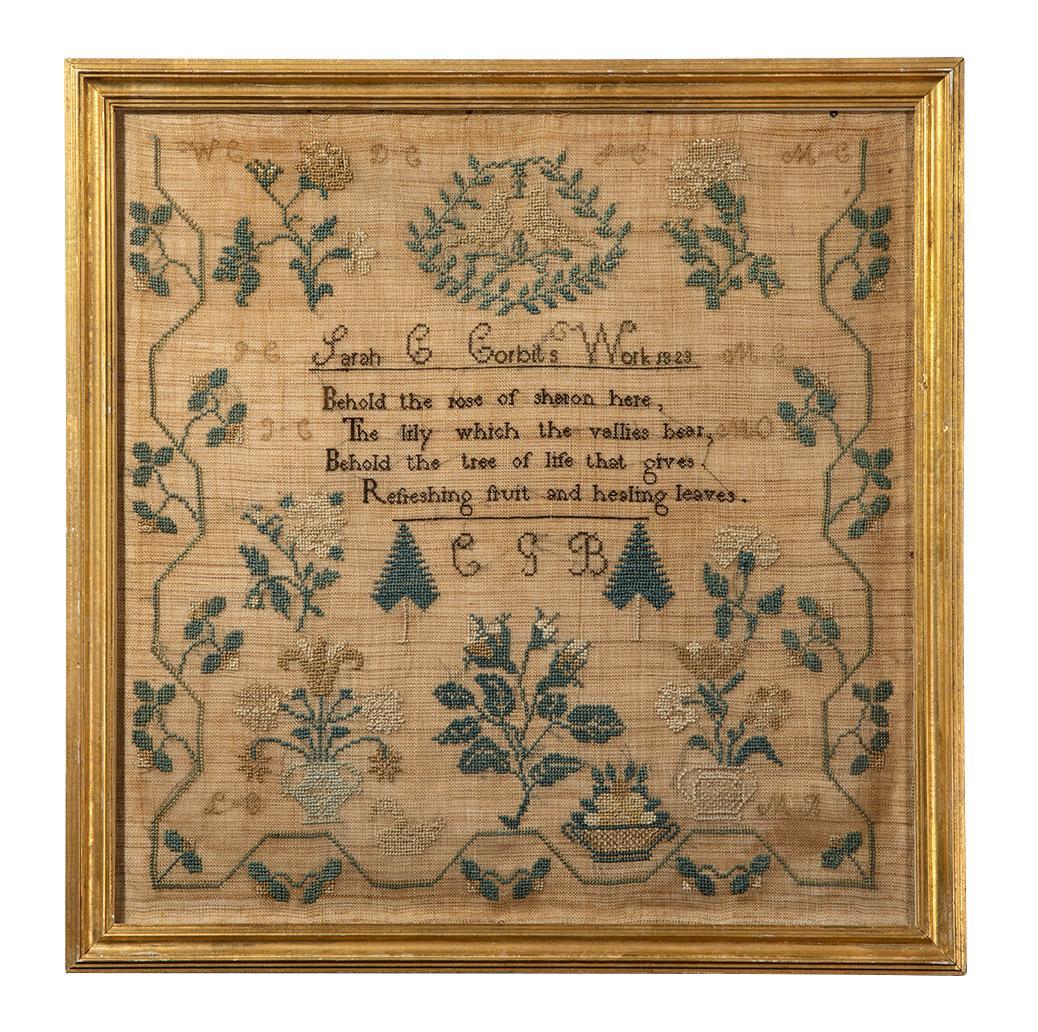Needlework sampler
Odessa, Delaware
1823
Maker
Sarah Clark Corbit (1810-1871)
Measurements
17 in x 16-3/8 in (sight)
Materials
Silk on linen
Credit Line
Historic Odessa Foundation, gift of Sara Corbit Reese Pryor
Accession Number
1977.222
Inscription
"Sarah C Corbit s Work 1823 / Behold the rose of sharon here / The lily which the vallies bear; / Behold the tree of life that gives, / Refreshing fruit and healing leaves. / G S B” is wrought in a text block in the center. Ten paired initials–WC, DC, SC, MC, PC, MC, JC, MO, LC, MB–are spaced symmetrically throughout the sampler.
Condition Notes
The linen exhibits some staining, and yellow dyes appear to have faded.
Provenance
The sampler descended from Sarah, the maker, to her daughter Mrs. Daniel Wheeler (Mary Clark Higgins) Corbit (1847–1909), to Sara Clark Corbit Curtis Levis (1871–1952), to the donor. Brown paper removed from the back of the frame has in pencil under later ink inscriptions, “Given to Sara Corbit Reese / by her grandmother / Sara Clark Corbit Curtis Levis - August 1941."
Comments
This sampler was made at the same time as Sarah's sister Mary made hers (acc. no. 1971.1525). At the time, each child (aged 12 and 10, respectively) was orphaned and under the charge of her uncle Daniel Corbit. His account book records “2 quarters tuition” paid to “C. Bradford,” who was Catharine Golden Bradford (c. 1799–c. 1880) and “1 Silver thimble [bought] at Smyrna” for each girl to cover some of their schooling expenses. He also paid for a “gilt frame for sampler” under headings for each child. (See “Daniel Corbit account book, Cantwell’s Bridge,” acc. no. 1959.4041, entries dated Apr. 14, 1823, p. 156.)
The samplers incorporate motifs of long-standing popularity among Quakers. In addition to floral sprigs, they have paired love birds within geometric devices and a popular religious verse. Sarah’s drew from a hymn in Isaac Watts’s ubiquitous Hymns and Spiritual Songs, and Mary’s came from published school book texts. Ten paired initials, stitched in now-muted colors, occur symmetrically across the sampler. Although Delaware samplers often incorporated paired initials, whose identity has often been lost, the two samplers use identical paired letters in nearly identical placements. The top row of four pairs and the two in the next level represent paternal grandparents, uncle and aunt, and parents. Identities of the lower two levels are more puzzling. Family surnames included Corbit, Clark, and Cowgill, which may address two paired initials, but MO and MB remain unresolved.
Bibliography
Susan Burrows Swan, “Delaware Samplers,” in The Delaware Antiques Show catalogue (Wilmington, Del., December 6–8, 1985), 55–56.
Lynne Anderson and Gloria Seaman Allen, Wrought with Careful Hand: Ties of Kinship on Delaware Samplers (Dover, Del.: Biggs Museum of American Art with the Sampler Consortium, 2014), 75.
Gloria Seaman Allen and Cynthia Shank Steinhoff, DelawareDiscoveries: Girlhood Embroidery, 1750-1850 (Baltimore, MD.; Chesapeake Book Co. for the Biggs Museum of American Art, 2019), 287-89.
Zimmerman, A Storied Past, 182-185.
